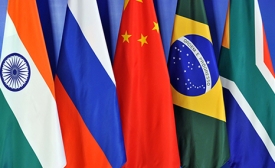brics
Brands from Brazil are capturing global attention and allegiance, while their Asian counterparts among the 'BRIC' countries, China and India lag behind, writes Jerry Clode, who leads cultural insight in Asia-Pacific for brand-development consultancy Added Value.
"We recognise that countries such as China, India and Brazil are gaining influence less because of the size of their armies than because of the growth of their economies," Clinton wrote in an oped in 'New Statesman' published yesterday.
Alexis-Marchay Karklins, co-leader of the center of emerging markets at Ernst & Young, said that “recent trends have made the deployment and use of soft power crucial and it is not surprising that the BRIC countries (Brazil, Russia, India and China) dominate this index.
A so-called brand ranking of countries, which was held recently by the UK Brand Finance company, shows that Russia, among other BRICS countries, is still very popular with foreign businesspeople as an object for investments.
Among the BRICS country rankings, Matola points out that only South Africa and Russia, which improved from 49th to 48th, gained ground. Brazil slipped from 44th to 46th, India from 32nd to 35th and China from 19th to 23rd.
The Rapid Growth Soft Power Index consists of three criteria: integrity, global integration and image. Although year-on year changes do occur in the rankings, the absolute changes are not large, demonstrating that a strong power brand typically takes many years to acquire or lose.

Sherine B. Walton, Editor-in-Chief
Naomi Leight, Managing Editor
Kia Hays, Associate Editor
By now, nearly everyone has heard of the BRICS. Less known are the CIVETS (Colombia, Indonesia, Vietnam, Egypt, Turkey and South Africa) and MIST (Mexico, Indonesia, South Korea and Turkey). These acronyms are the product of brilliant branding, but they tell us nothing about why these countries were chosen as the ones best built to last.







